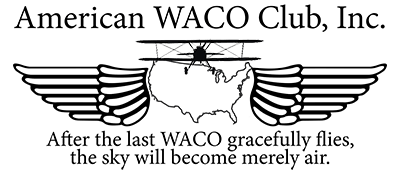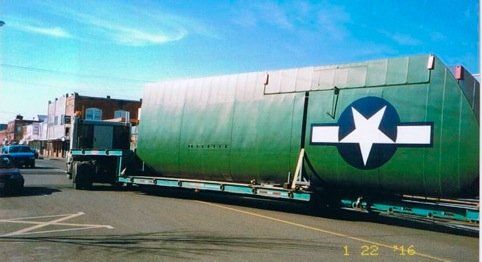WACO Goes to WAR!
While most of us know WACO was famous for its' civilian airplanes, it also made a major contribution to the Allied victory in WWII. WACO not only produced the UPF-7 for the Civilian Pilot Training Program, but also designed and built gliders which were used to transport men and materials to combat areas. Towed behind C-47 Transports, these gliders were cut loose and landed in enemy held fields, skidding to a stop and then unloading soldiers and equipment.
The Restoration of a CG-4A "Hadrian" Invasion Glider
The following article about the restoration of a CG-4A "Hadrian" Invasion Glider is courtesy of AWC member Linda Buroker-Melhoff.
A DIFFERENT KIND OF WACO RESTORATION
THE CG-4A "Hadrian" GLIDER
by Linda Buroker-Melhoff
As Mr. Seifert stated in his recent article, the amazing WACO Invasion Gliders of WWII are not often mentioned. I had the privilege of interviewing two talented craftsmen who are responsible for the restoration of two CG-4's in 1995/96 at Lenhardt's Air Haven where our WACO Taperwing is hangared in Oregon.
Jack Lenhardt's business, Lenair Restorations, was selected by the US Army to restore two CG-4A Gliders which could be displayed in US Army Museums. Lenair was provided three rusty fuselages and some miscellaneous parts to begin the restoration project.
The Glider Pilots Association and the Silent Wings Museum were enthusiastic about the project and assisted Lenair in finding individuals who were working on restorations so they could trade extra parts for parts they needed. Jim Prosser and Doug Coleman were sent on a mission across the US from New Hampshire to Texas to obtain necessary parts and components.
They were fortunate to find some rare and valuable components, among which was an instrument panel complete with all the original placarding. They found a second panel only missing the placarding which was easy to duplicate. What they were unable to buy or trade for had to made. Doug's skill and experience as a machinist was extremely valuable in many facets of the restoration.
They used 35mm microfilm from the Ford Motor Company, one of the producers of the GC-4A during WWII but in many cases there were no definitive plans. Jim took charge of the fuselage, tail and related areas and Doug and his crew were responsible for building the wings. Some of the wood work was sub-contracted to a local cabinet maker.
Jim ordered 250 yards of fabric 70 inches wide to cover only the two fuselages. It took another 100 yards of fabric to cover the wings. They used 70 gallons of paint for the fuselages and tails.
All methods of construction were duplicates of original. They paid attention to every detail, down to attaching the stringers by wrapping rib stitching cord an exact number of times and tying the cord off just as it was done originally. Both finished gliders included an original drogue chute and very pistol.
It is difficult to imagine the size of these gliders. Each aileron was about the size of airplane wings, 16 feet long by 30 inches wide. Here are some facts:
Wing Span- 83 ft, 8 in
Length – 48 ft, 4 in
Height – 12 ft, 7 in
Weight- 7,500 lbs loaded
The CG-4A was capable of carrying 13 troops and their equipment or either a jeep, a quarter-ton truck or a 75 mm howitzer in addition to 2 crew members. The tow ropes were 200 feet long and sometimes were attached to two poles so the tow plane, usually a C-47, could fly over and grab it with a hook.
The gliders were used in eight separate invasions during WWII and in the China-Burma Theater. There were many crashes and fatalities. Upon successful landings, the pilots were instructed to make their way back across enemy lines or join the infantry and start fighting. Some said they would rather face the enemy than fly another mission.
Fast forward about 50 years to Hubbard, Oregon where the glider association has been monitoring the progress at Lenair Restorations. The International Glider Pilots Reunion was scheduled for October 1996 in Portland, Oregon which would coincide with completion of the CG-4A fuselages. This would allow some original crew members to see, touch and sit in the cockpits. Eight busloads of pilots and spouses were brought to Lenhardt's Air Haven where they enjoyed a day with the CG-4A's and were treated to a BBQ and a display of other WWII machines and equipment. It was a moving experience for the pilots, their families and the restoration crews.
Mr. Seifert asked if anyone knew if there were CG's left in museums anywhere. The two Gliders described above were restored for display in the National Museum of the US Air Force/National Infantry Museum in Ft. Benning, Georgia and the Airborne and Special Operations Museum, Fayetteville, North Carolina. Jim Prosser tells me he believes these may be the only two commercially restored CG-4A's. However, there have been other restorations by private parties and organizations.
Lenair Restorations donated all surplus parts and components from their restoration to the Silent Wings Museum along with all jigs and patterns. They also donated a completely restored nose section, an uncovered nose section floor, and complete tail cone all to be used as samples for others working on CG-4A restorations. I believe there is at least one complete CG-4A Glider on display in the Silent Wings Museum in Lubbock, Texas.









